Simulation and Optimization of New Energy Vehicles Promotion Policy Strategies Considering Energy Saving, Carbon Reduction, and Consumers’ Willingness Based on System Dynamics
Abstract
1. Introduction
- (1)
- Innovation 1: Algorithm Incorporating Consumer Reference Effect
- (2)
- Innovation 2: System Dynamics Model for Energy Saving and Carbon Reduction
2. Method and Model
2.1. Method
- (1)
- The five-step modeling approach of system dynamics is as follows: First, the system boundaries are defined, a causal loop diagram is constructed, and causality analysis is conducted. Next, the SD model is established, and validation is performed. Then, the dynamic simulations of key variables are conducted under different scenarios. After that, the solutions are optimized based on the simulation results. Finally, the countermeasures are proposed to enhance the energy-saving and carbon reduction effects of new energy vehicles.
- (2)
- Nudge Theory is a behavioral science theory proposed by behavioral economists Richard Thaler and Cass Sunstein. Its core idea is to guide people toward making better decisions in a non-coercive manner by designing choice architecture without restricting their freedom of choice. The basic principles include influencing people’s behavior through small, low-cost design changes and designing interventions based on principles from psychology and behavioral economics (e.g., loss aversion, herd mentality). The implementation of Nudge Theory typically involves the following steps: first, clarifying the behavior or decision that needs to be changed; second, analyzing the behavioral patterns and psychological motivations of the target group and identifying key factors influencing behavior; and finally, developing nudge strategies, such as default options, framing effects, social norms, and so on.
2.2. New Energy Vehicle Energy-Saving and Carbon Reduction System Circuit
2.3. Stock Flow Charts
2.4. Determine Model Parameters
- (1)
- Zhengzhou Statistical Yearbook: initial value of urban Gross Domestic Product (GDP), initial value of urban population, initial value of new energy vehicle ownership, initial value of fuel private car ownership, etc.
- (2)
- Reference to existing literature: automobile scrapping rate, private car travel ratio, new energy vehicle substitution effect, influence of charging policy on consumers’ purchase intention, etc.
- (3)
- SD-RA forecast: GDP growth rate, population growth rate, etc.
3. SD-RA-RE Algorithm and Main Equations
3.1. SD-RA-RE Algorithm
- Step 1: Searching for the influencing factors
- Step 2: Predicting the impact factors
- (1)
- Calculating the average of X and Y, denoted as X, Y.
- (2)
- Calculating the covariance of X and Y as follows:
- (3)
- Calculating the slope b as follows:
- (4)
- Calculating the intercept as follows:
- (5)
- Using the formula to predict the total GDP and total population of a city.
- Step 3: Establishing the regression analysis equation
- (1)
- Determining the independent variable as GDP per capita and the dependent variable as the number of new energy private cars.
- (2)
- Regression analysis equation=2943.82 × (GDP per capita)3 – 33,189.55 × (GDP per capita)2 + 627,075.466.
- (3)
- Calculating R2, significance, and testing.
- Step 4: Constructing the SD-RA model
- (1)
- The regression prediction equation is as follows: number of new energy vehicles=
- (2)
- Calculating and predicting the number of new energy private cars: calculating the number of new energy private cars in 2016, 2019, and 2021 based on the predicted per capita GDP and predicting the number of new energy private cars from 2023 to 2030.
- (3)
- Calculating the growth rate of new energy private cars.
- (4)
- Using Vensim software to characterize the nonlinear relationship between variables. Based on the growth rate of new energy private cars obtained in the above steps, the table function of Vensim software is used to characterize the nonlinear relationship between variables as follows:
- Step 5: Calculating the impact of price reference effect
- (1)
- Calculating the total cost of new energy vehicles, recorded as t,
- (2)
- Calculating the consumer’s valuation of new energy vehicles, recorded as v.
- (3)
- The customer’s price sensitivity coefficient, recorded as θ.
- (4)
- The cost savings after implementing the policy of reducing charging fees, recorded as s,
- (5)
- The impact of the price reference effect is as follows:ƍ = (v – t + θ × s)/(v − t).
- Step 6: Calculating the growth rate of new energy vehicles
- (1)
- Consumers’ willingness to buy increases as follows:£ = Ɛ × (ƍ − 1).
- (2)
- The new energy vehicle growth rate is as follows:
3.2. Main Equations
- (1)
- Total urban GDP = INTEG (GDP growth, 9.3 × 1012), unit: CNY;
- (2)
- Total urban population = INTEG (net population growth, 1.1643 × 108), unit: person;
- (3)
- GDP per capita = total urban GDP/total urban population, unit: CNY/person;
- (4)
- Growth rate of new energy vehicles = function of growth rate of new energy private cars × (1 + increase in consumer purchasing willingness);
- (5)
- Fuel consumption per 100 km of fuel private cars = 7.76, unit: liters/100 km;
- (6)
- Carbon emission factor of fuel private cars = 0.002056, unit: tons/vehicle (Table 2).
4. Dynamic Simulation Analysis
4.1. Model Verification and Testing
4.2. Model Verification
4.2.1. Extreme Conditions Testing
4.2.2. Validity Test
4.3. Dynamic Simulation Analysis
4.3.1. Policy on Reducing or Exempting Charging Fees
4.3.2. Combination Strategy
4.4. Discussion
4.4.1. Effect of Reducing Charging Fees
4.4.2. Policy Lag Effect
4.4.3. Strategic Offset
5. Conclusions
5.1. Main Conclusions
- (1)
- Both the single charging fee reduction strategy and the combination strategy can increase the sales of new energy vehicles. With the rise in oil prices, the travel cost of traditional fuel vehicles increases, while the reduction in charging fees reduces the travel cost of new energy vehicles, which helps to increase the willingness to buy new energy vehicles. Among the single charging fee reduction strategies, scheme 3 has the best effect. The growth of new energy vehicles at the end of 2030 reached 1,187,490 vehicles, an increase of 173.52% compared with not implementing the charging fee reduction. Among the combination strategies, scheme 9 is the best. At the end of 2030, the number of new energy vehicles in use reached about 6.19 million, with a growth rate of 253.03%. The above simulation results show that the reduction in charging fees and the combination strategy can increase the sales of new energy vehicles.
- (2)
- The combination of strategies scheme 7, scheme 8, and scheme 9 can achieve the “carbon peak” of fuel vehicles before 2030. Schemes 7–9 As the efforts to reduce charging fees increase and consumers become more sensitive to prices, the surge in new energy vehicles will replace fuel vehicles on a large scale, reducing the use of fossil energy from the source, thereby reducing greenhouse gas emissions. According to the simulation results of scheme 9, it can be found that by 2030, carbon dioxide emissions will drop by about 38.85%, and will then decline after reaching a peak in 2027. Compared to the initial scenario, the number of new energy vehicles in Scenario 9 has reached 6,195,240 units, representing an increase of 253.03%. Additionally, carbon dioxide emissions have been reduced, with emissions decreasing to 8,804,370 tons by the end of 2030, a reduction of approximately 38.85%.
- (1)
- Expanding the scale of charging stations: After the implementation of the reduction in charging fees, the number of new energy vehicles will increase, increasing the demand for charging infrastructure. If the infrastructure cannot meet the charging needs of residents, this may greatly reduce the effectiveness of this strategy. Therefore, while increasing the willingness to buy new energy vehicles, it is also necessary to promote the construction of charging stations and improve the convenience of new energy charging. In addition, the length of charging time will also affect consumers’ willingness to buy new energy vehicles. Improve charging efficiency while improving the infrastructure of new energy vehicles.
- (2)
- Enhancing the charging efficiency: The level of charging efficiency is also a significant factor influencing consumers’ purchasing decisions. Therefore, to promote the adoption of new energy vehicles, improving charging efficiency is a crucial issue.
- (3)
- Extending the battery life: Our battery manufacturers need to invest more in technology to prolong the service life of batteries. For consumers, the high cost of battery replacement can be reduced, making new energy vehicles more economically attractive. Additionally, the production and recycling of batteries generate significant amounts of carbon dioxide and pollutants. Therefore, extending battery life can effectively mitigate the negative environmental impact of batteries, contributing to the achievement of dual-carbon goals. Finally, prolonging battery life can significantly enhance the competitiveness of Chinese new energy vehicles in the international market.
5.2. Future Outlook
- (1)
- Since cost is a key factor in purchasing new energy vehicles [29], the cost of using new energy vehicles can be reduced by reducing charging fees and increasing consumers’ sensitivity to them, thereby stimulating customers to choose new energy vehicles instead of traditional fuel vehicles and fundamentally reducing the travel volume, energy consumption, and carbon dioxide emissions of traditional fuel private cars. However, the implementation of the combined policy will stimulate the rapid increase in the number of new energy vehicles, which will increase the number of charging stations and the pressure to improve charging efficiency. When charging facilities cannot meet consumers’ charging needs, negative word of mouth may be generated, aggravating the public’s anxiety about new energy vehicles, which is not conducive to the healthy and long-term development of the new energy vehicle industry. Therefore, while implementing this policy, the number of charging stations and its convenience must also be guaranteed.
- (2)
- Future research should also expand from the perspective of technological innovation, enhancing the energy-saving and carbon reduction effects of new energy vehicles through technological advancements, thereby contributing to the achievement of the dual-carbon goals.
Author Contributions
Funding
Institutional Review Board Statement
Informed Consent Statement
Data Availability Statement
Acknowledgments
Conflicts of Interest
Appendix A. Main Parameters and Equations
| Variable | Type | Formula | Source |
| Average annual mileage of new energy private cars | Constant | 157.717 | [36] |
| Average annual mileage of fuel private cars | Constant | 167.024 | [36] |
| Private car travel ratio | Constant | 0.55 | [35] |
| New energy vehicle substitution effect | Constant | 0.3172 | [34] |
| Scrap rate of fuel powered private cars | Constant | 0.0667 | [37] |
| Net Population growth | Auxiliary | Net Population growth = Total urban population × Net population growth rate | Computed according to the facts |
| GDP per capita | Auxiliary | GDP per capita = total urban GDP/total urban population | Computed according to the facts |
| Total urban population | Level | INTEG(Net population growth, 1.0692 × 107) | SD-RA Model |
| Population growth rate | Auxiliary | WITHLOOKUP(Time, ([(0, 0) − (4000, 10)], (2018, 0.03513), (2019, 0.02514), (2020, 0.02121), (2021, 0.00991), (2022, 0.00675), (2023, 0.01403), (2024, 0.01799), (2025, 0.01435), (2026, 0.01444), (2027, 0.01438), (2028, 0.0144), (2029, 0.01434), (2030, 0.01441))) | SD-RA Model |
| The number of new energy private cars | Level | (2015, 5000), (2017, 36,892), (2018, 51,045), (2020, 139,904), (2022, 256,000), (2023, 380,000) | Official website data |
| The total GDP of the city | Level | (2015, 7350), (2016, 8130), (2017, 9300), (2018, 10,670), (2019, 11,590), (2020, 11,850), (2021, 12,540), (2022, 12,930) | Official website data |
| Population data | Level | (2015, 1069.2), (2016, 1119.4), (2017, 1164.3), (2018, 1205.2), (2019, 1235.5), (2020, 1261.7), (2021, 1274.2), (2022, 1282.8) | Official website data |
References
- Yao, X.S.; Shao, Z.Q.; Wang, Z.; Zhu, Z.; Chen, Z.X.; Wu, Q.Y. Policy incentives and market mechanisms dual-driven framework for new energy vehicles promotion. Energy Policy 2025, 199, 114530. [Google Scholar] [CrossRef]
- Fander, A.; Yaghoubi, S. Dynamic and stochastic modeling for a closed-loop automotive supply chain under fuel issue and government intervention: A case study. Comput. Ind. Eng. 2022, 174, 108765. [Google Scholar] [CrossRef]
- Bu, C.J.; Cui, X.Q.; Li, R.Y.; Li, J.; Zhang, Y.X.; Wang, C.; Cai, W.J. Achieving net-zero emissions in China’s passenger transport sector through regionally tailored mitigation strategies. Appl. Energy 2021, 284, 116265. [Google Scholar] [CrossRef]
- Chen, Y.; Luo, Q.I.; Chongsen, M.A. Carbon unlocking efficiency study based on super-efficiency SBM-Malmquist. Rairo-Oper. Res. 2024, 58, 457–474. [Google Scholar] [CrossRef]
- Zhao, C.Y.; Wang, K.; Dong, X.C.; Dong, K.Y. Is smart transportation associated with reduced carbon emissions? The case of China. Energy Econ. 2025, 105, 105715. [Google Scholar] [CrossRef]
- Chen, L.; Ma, R. Clean energy synergy with electric vehicles: Insights into carbon footprint. Energy Strategy Rev. 2024, 53, 101394. [Google Scholar] [CrossRef]
- Lin, J. Effects of electric vehicle demonstration and promotion policy on air pollution: Evidence from China. Transp. Policy 2025, 162, 1–19. [Google Scholar] [CrossRef]
- Li, P.; Zhang, Z.X. The effects of new energy vehicle subsidies on air quality: Evidence from China. Energy Econ. 2023, 120, 106624. [Google Scholar] [CrossRef]
- Xie, D.; Gou, Z.H.; Gui, X.C. How electric vehicles benefit urban air quality improvement: A study in Wuhan. Sci. Total Environ. 2024, 906, 167584. [Google Scholar] [CrossRef] [PubMed]
- Cai, J.Y.; Zhu, M.Z.; Wu, J.; Chen, X.L.; Xu, J.J.; Shen, Z.Y. Evaluating the impact of new energy vehicle subsidies on urban carbon emissions: Evidence from 261 Chinese cities. Renew. Energy 2025, 240, 122261. [Google Scholar] [CrossRef]
- Yu, Y.M.; Xu, H.; Cheng, J.P.; Wan, F.; Ju, L.; Liu, Q.Z.; Liu, J. Which type of electric vehicle is worth promoting mostly in the context of carbon peaking and carbon neutrality? A case study for a metropolis in China. Sci. Total Environ. 2022, 837, 155626. [Google Scholar] [CrossRef] [PubMed]
- Qiao, D.D.; Wei, X.Z.; Fan, W.J.; Jiang, B.; Lai, X.; Zheng, Y.J.; Tang, X.L.; Dai, H.F. Toward safe carbon–neutral transportation: Battery internal short circuit diagnosis based on cloud data for electric vehicles. Appl. Energy 2022, 317, 119168. [Google Scholar] [CrossRef]
- Liu, Y.X.; Li, H.J.; An, H.Z.; Guan, J.H.; Shi, J.L.; Han, X.D. Are the environmental impacts, resource flows and economic benefits proportional? Analysis of key global trade routes based on the steel life cycle. Ecol. Indic. 2021, 122, 107306. [Google Scholar] [CrossRef]
- Liu, Y.X.; Li, H.J.; Ren, H.J.; Jiang, H.D.; Ren, B.; Ma, N.; Chen, Z.S.; Zhong, W.Q.; Ulgiati, S. Shared responsibility for carbon emission reduction in worldwide “steel-electric vehicle” trade within a sustainable industrial chain perspective. Ecol. Econ. 2025, 227, 108393. [Google Scholar] [CrossRef]
- Li, Z.Z.; Zhu, N.G.; Wen, X.; Liu, Y. Assessment the impact of power generation hours on the abatement costs of CCUS on coal-fired power plants in China. Energy Econ. 2025, 144, 108305. [Google Scholar] [CrossRef]
- Wang, Q.Z.; Xia, F.; Liu, M.D. Substitution or expansion: Effects of new energy vehicle subsidies on air quality. J. Environ. Manag. 2025, 377, 124538. [Google Scholar] [CrossRef]
- Wang, Y.Y.; Fan, R.G.; Lin, J.C.; Chen, F.Z.; Qian, R.R. The effective subsidy policies for new energy vehicles considering both supply and demand sides and their influence mechanisms: An analytical perspective from the network-based evolutionary game. J. Environ. Manag. 2023, 325, 116483. [Google Scholar] [CrossRef]
- Wang, Y.D.; Mao, J.Q.; Chen, F.; Wang, D.L. Uncovering the dynamics and uncertainties of substituting coal power with renewable energy resources. Renew. Energy 2022, 193, 669–686. [Google Scholar] [CrossRef]
- Li, J.C.; Jiang, M.R.; Li, G. Does the new energy vehicles subsidy policy decrease the carbon emissions of the urban transport industry? Evidence from Chinese cities in Yangtze River Delta. Energy 2024, 298, 131322. [Google Scholar] [CrossRef]
- Sun, C.W.; Xu, S.H.; Yang, M.; Gong, X. Urban traffic regulation and air pollution: A case study of urban motor vehicle restriction policy. Energy Policy 2022, 163, 112819. [Google Scholar] [CrossRef]
- Chen, J.; Wang, Y.S.; Xu, Y.Y.; Shi, J.Y. Dual-credit policy failure: The emergence principle and hedging mechanisms. Energy Econ. 2025, 141, 108124. [Google Scholar] [CrossRef]
- Shang, Y.T.; Li, D.; Li, Y.; Li, S. Explainable spatiotemporal multi-task learning for electric vehicle charging demand prediction. Appl. Energy 2025, 384, 125460. [Google Scholar] [CrossRef]
- Li, Z.M.; Wu, L.; Xu, Y.; Zheng, X.D. Stochastic-weighted robust optimization based bilayer operation of a multi-energy building microgrid considering practical thermal loads and battery degradation. IEEE Trans. Sustain. Energy 2022, 13, 668–682. [Google Scholar]
- Liang, X.M.; Wang, P.; Cao, X.; Wan, X.M.; Chao, P.P.; Zhang, X.; Yu, A.D.; Liu, C.; Li, J.L. Research on improving the safety of new energy vehicles exploits vehicle operating data. Saf. Sci. 2024, 181, 106681. [Google Scholar] [CrossRef]
- Ma, X.Y.; Lu, C.X.; Gao, J.W.; Cao, J.; Wam, Y.H.; Fang, H. Sustainability of new energy vehicles from a battery recycling perspective: A bibliometric analysis. Heliyon 2024, 10, e33800. [Google Scholar] [CrossRef] [PubMed]
- Yi, Y.X.; Fu, A.; Li, Y.Q.; Zhang, A.X. Battery recycling and coordination in information leakage prevention under blockchain technology in a new energy vehicles supply chain. Energy Econ. 2024, 139, 107862. [Google Scholar] [CrossRef]
- Jia, C.C.; Liu, W.; He, H.W.; Chau, K.T. Deep reinforcement learning-based energy management strategy for fuel cell buses integrating future road information and cabin comfort control. Energy Convers. Manag. 2024, 321, 119032. [Google Scholar] [CrossRef]
- Jia, C.C.; He, H.W.; Zhou, J.M.; Li, J.W.; Wei, Z.B.; Li, K.A. Learning-based model predictive energy management for fuel cell hybrid electric bus with health-aware control. Appl. Energy 2024, 355, 122228. [Google Scholar] [CrossRef]
- Buhmann, K.M.; Criado, J.R. Consumers’ preferences for electric vehicles: The role of status and reputation. Transp. Res. Part D Transp. Environ. 2023, 114, 103530. [Google Scholar] [CrossRef]
- Sahoo, D.; Harichandan, S.; Kar, S.K.; Sreejesh, S. An empirical study on consumer motives and attitude towards adoption of electric vehicles in India: Policy implications for stakeholders. Energy Policy 2022, 165, 112941. [Google Scholar] [CrossRef]
- Bi, C.; Jin, S.J.; Li, S.Z.; Li, Y.N. Can green advertising increase consumers’ purchase intention of electric vehicles? An experimental study from China. J. Clean. Prod. 2023, 419, 138260. [Google Scholar] [CrossRef]
- Song, Y.; Chen, B.; Hou, N.; Yang, Y. Terrorist attacks and oil prices: A time-varying causal relationship analysis. Energy 2022, 246, 123340. [Google Scholar] [CrossRef]
- Sun, H.Q.; Jing, P.; Wang, B.H.; Cai, Y.H.; Ye, J.; Wang, B.C. The effect of record-high gasoline prices on the consumers’ new energy vehicle purchase intention: Evidence from the uniform experimental design. Energy Policy 2023, 175, 113500. [Google Scholar] [CrossRef]
- Guo, X.D.; Wang, F. Government Subsidies, Demand Substitution and Emission Reduction Effects under the “Dual Carbon” Target: Evidence from the Chinese Passenger Car Market. Res. Quant. Tech. Econ. 2024, 41, 131–150. [Google Scholar]
- Zhu, M.H. Socio-Economic Impact Analysis of Urban Traffic Congestion. Master’s Thesis, Beijing Jiaotong University, Beijing, China, 2013. [Google Scholar]
- Liu, N.; Kong, J. Research on Consumer Choice Behavior of New Energy Vehicles with the Introduction of a Carbon Reward Mechanism. Soft Sci. 2024, 38, 49–57. [Google Scholar] [CrossRef]
- Jia, S.W. Research on the Double Dividend Effect of Control Strategies for Reducing Motor Vehicle Pollutant Emissions. Manag. Rev. 2022, 34, 53–61+182. [Google Scholar] [CrossRef]
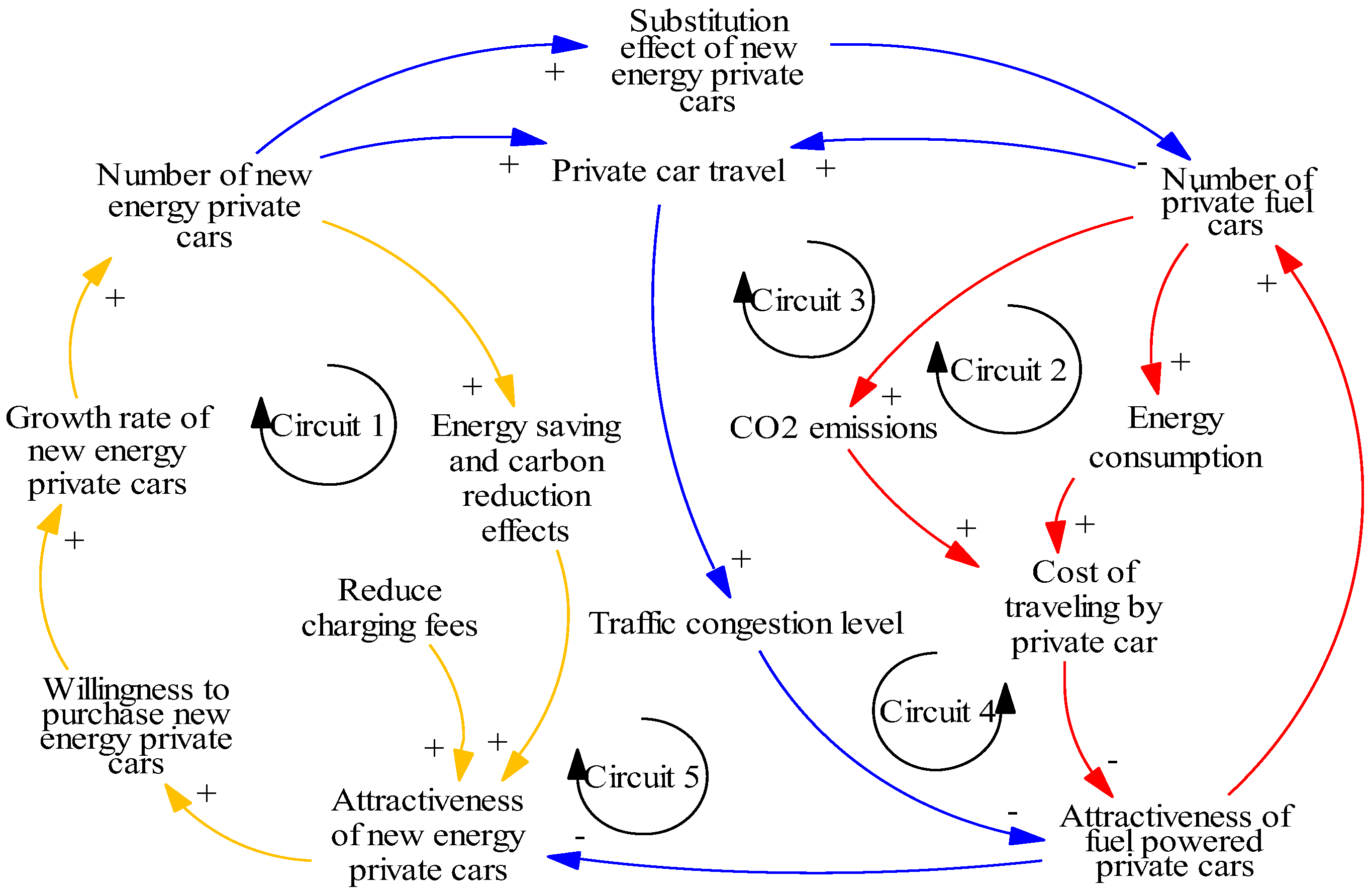
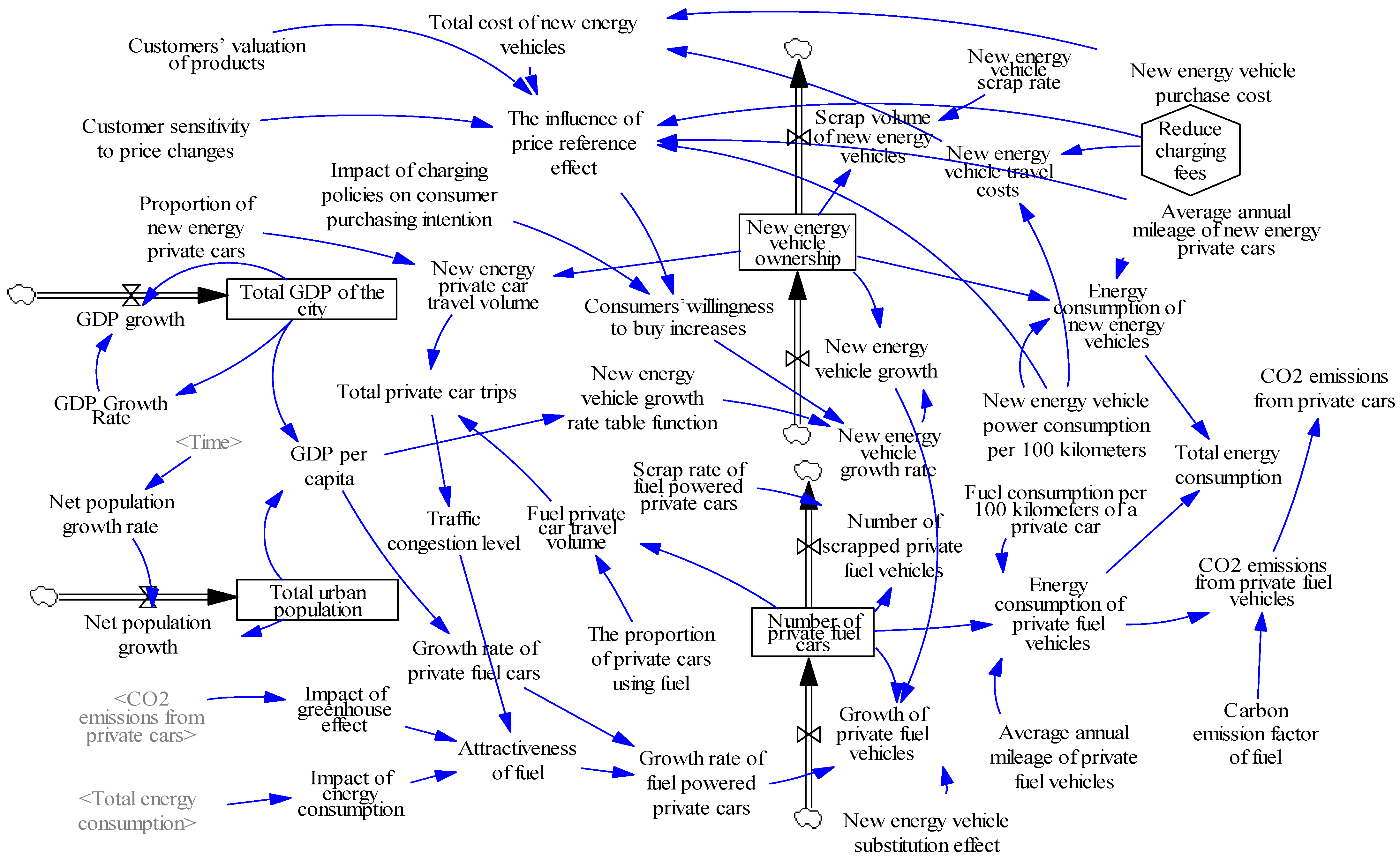




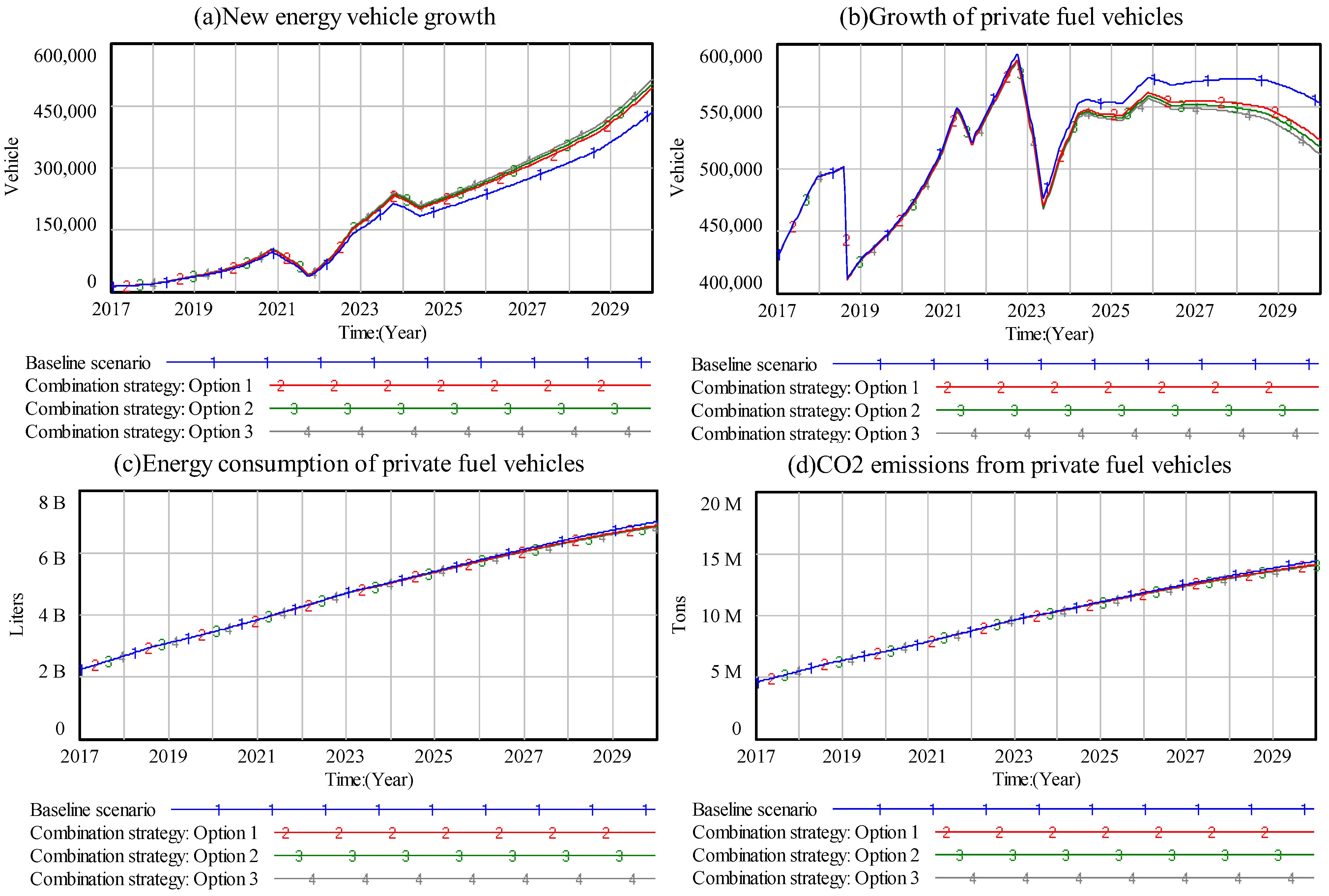

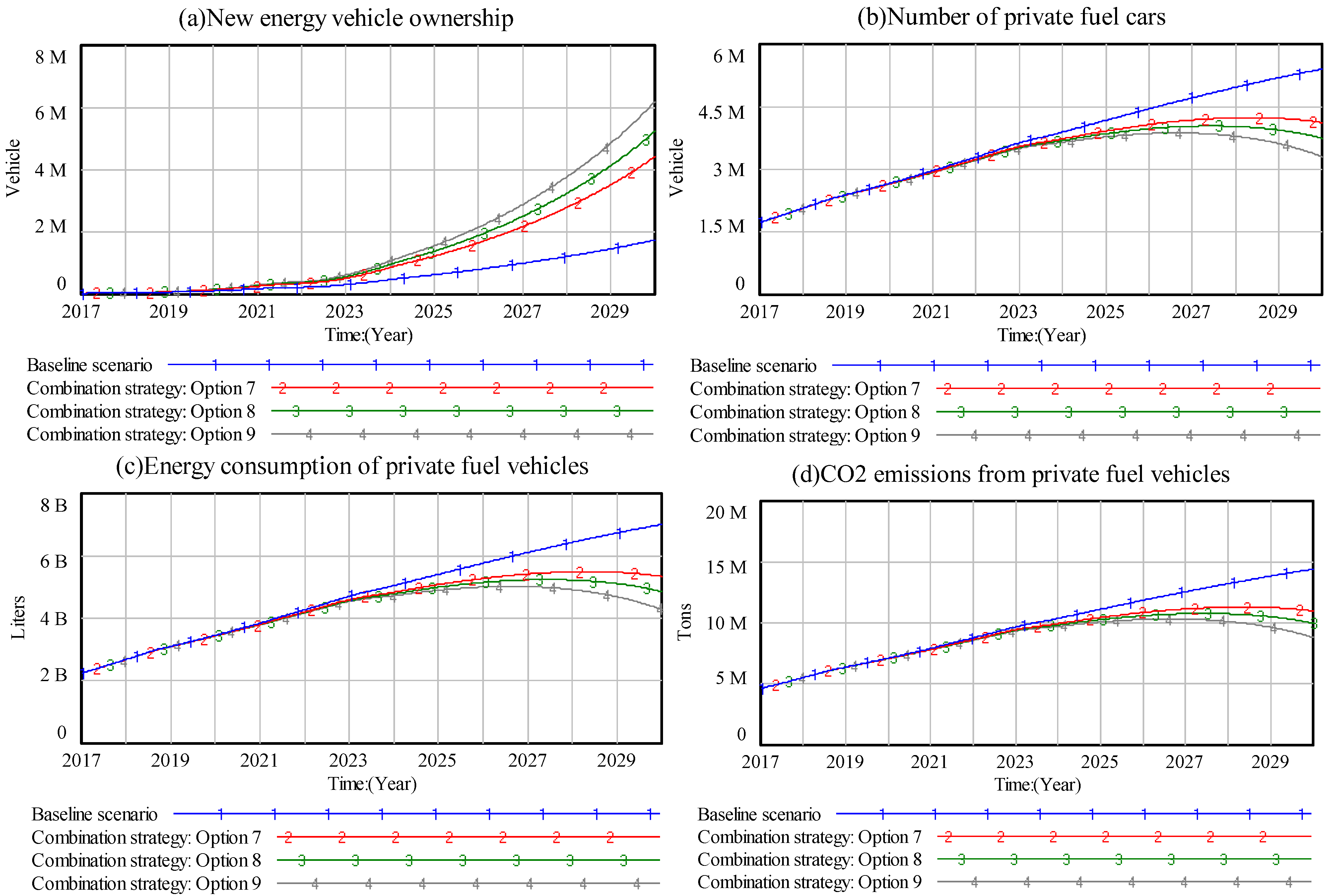
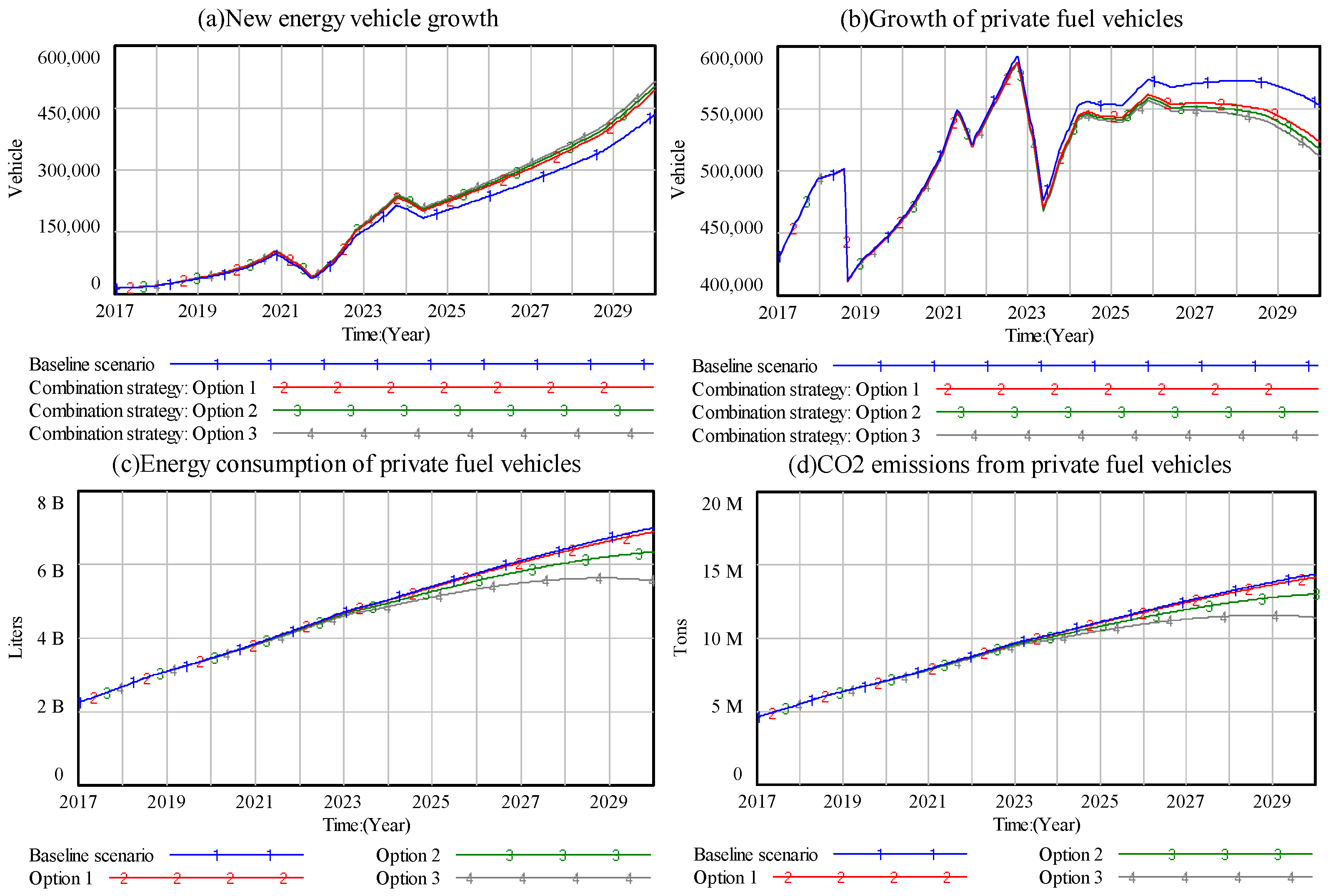
| Variable | Formula |
|---|---|
| the number of new energy private cars | (2015, 5000), (2017, 36,892), (2018, 51,045), (2020, 139,904), (2022, 256,000), (2023, 380,000) |
| the total GDP of the city | (2015, 7350), (2016, 8130), (2017, 9300), (2018, 10,670), (2019, 11,590), (2020, 11,850), (2021, 12,540), (2022, 12,930) |
| population data | (2015, 1069.2), (2016, 1119.4), (2017, 1164.3), (2018, 1205.2), (2019, 1235.5), (2020, 1261.7), (2021, 1274.2), (2022, 1282.8) |
| Variable | Type | Formula | Source |
|---|---|---|---|
| GDP growth rate | Auxiliary | WITHLOOKUP (Total GDP of the citym, ([(10,000, 0) − (40,000, 1)], (10,670, 0.1473), (11,590, 0.0862), (11,850, 0.0224), (12,540, 0.0582), (12,930, 0.0311), (13,620, 0.0534), (14,938, 0.0968), (15,921, 0.0658), (16,968, 0.0658), (18,084, 0.0658), (19,274, 0.0658), (20,542, 0.0658), (21,893, 0.0658))) | SD-RA Model |
| Traffic congestion level | Auxiliary | LN(1 + total number of private car trips/5 × 106) | — |
| The influence of price reference effect | Auxiliary | (Customer valuation of the Product − total cost of new energy vehicles + Customer sensitivity to price changes × (average annual mileage of new energy private cars × 8 × power consumption of new energy vehicles per 100 km × 1.2 × reduced charging fees/10,000))/ (customer valuation of the product—13—average annual mileage of new energy private cars × 1.2 × 8 × 11/10,000) | — |
| New energy vehicle substitution effect | Constant | 0.3172 | [34] |
| Growth of private fuel vehicles | Auxiliary | Number of private fuel cars × Growth rate of private fuel cars − Substitution effect of new energy vehicles × Growth of new energy vehicles | — |
| New energy vehicle growth rate table function | Auxiliary | WITHLOOKUP (GDP per capita, ([(8, 0) − (40,000, 10)], (8.853, 0.03836), (9.841, 0.5621), (10.08, 0.1714), (10.47, 0.4844), (11.104, 0.4874), (11.6, 0.3377), (12.117, 0.3114), (12.658, 0.2905), (13.222, 0.2736), (13.813, 0.2596), (14.429, 0.2474))) | SD-RA Model |
| Private car travel ratio | Constant | 0.55 | [35] |
| Population growth rate | Auxiliary | WITHLOOKUP (Time, ([(0, 0) − (4000, 10)], (2018, 0.03513), (2019, 0.02514), (2020, 0.02121), (2021, 0.00991), (2022, 0.00675), (2023, 0.01403), (2024, 0.01799), (2025, 0.01435), (2026, 0.01444), (2027, 0.01438), (2028, 0.0144), (2029, 0.01434), (2030, 0.01441))) | SD-RA Model |
| Variable | Formula |
|---|---|
| GDP | {(2015, 7350), (2016, 8130), (2017, 9300), (2018, 10,670), (2019, 11,590), (2020, 11,850), (2021, 12,540), (2022, 12,930), (2023, 13,620), (2024, 14,938), (2025, 15,921), (2026, 16,968), (2027, 18,084), (2028, 19,274), (2029, 20,542), (2030, 21,893)} |
| Population | {(2015, 1069.2), (2016, 1119.4), (2017, 1164.3), (2018, 1205.2), (2019, 1235.5), (2020, 1261.7), (2021, 1274.2), (2022, 1282.8), (2023, 1300.8), (2024, 1345.3), (2025, 1372.5), (2026, 1400.3), (2027, 1428.7), (2028, 1457.7), (2029, 1487.2), (2030, 1517.3)} |
| GDP per capita | GDP/Population |
| Variable | Coefficient |
|---|---|
| (Per capita GDP)2 | −33,189.55 |
| (Per capita GDP)3 | 2943.82 |
| Constant | 627,075.466 |
| Year | 2017 | 2018 | 2019 | 2020 | 2021 | 2022 | 2023 |
|---|---|---|---|---|---|---|---|
| Real value | 7.988 | 8.853 | 9.381 | 9.392 | 9.841 | 10.080 | 10.470 |
| Analog value | 7.988 | 8.932 | 9.508 | 9.567 | 9.886 | 10.163 | 10.588 |
| Relative error | 0 | 0.89% | 1.36% | 1.86% | 0.45% | 0.83% | 1.12% |
| Year | 2017 | 2018 | 2019 | 2020 | 2021 | 2022 | 2023 |
|---|---|---|---|---|---|---|---|
| Real value | 1164.3 | 1205.2 | 1235.5 | 1261.7 | 1274.2 | 1282.8 | 1300.8 |
| Analog value | 1164.3 | 1205.91 | 1242.97 | 1272.18 | 1292.36 | 1303.23 | 1316.69 |
| Relative error | 0 | 0.06% | 0.6% | 0.83% | 1.43% | 1.59% | 1.22% |
| Variant | Baseline Scenario | Reduced Charging Costs: Program III | Rate of Change |
|---|---|---|---|
| Growth in new energy vehicles (Units) | 434,159 | 1,187,490 | 173.52% |
| Growth in fuel private cars (Units) | 552,863 | 178,586 | −67.7% |
| Energy consumption of fuel private cars (Liters) | 7.00237 × 109 | 5.55915 × 109 | −20.61% |
| CO2 emissions from fuel private cars (Tons) | 1.43969 × 107 | 1.14296 × 109 | −20.61% |
| Variant | Baseline Scenario | Portfolio Strategy: Option 3 | Rate of Change | Portfolio Strategy: Option 6 | Rate of Change |
|---|---|---|---|---|---|
| Growth in new energy vehicles (Units) | 434,159 | 514,498 | 18.5% | 1,006,110 | 131.74% |
| Growth in fuel private vehicles (Units) | 552,863 | 511,510 | −7.48% | 266,600 | −51.78% |
| Fuel private car energy consumption (Liters) | 7.00237 × 109 | 6.83312 × 109 | −2.4170% | 5.8846 × 109 | −15.9627% |
| Carbon dioxide emissions from fuel private cars (Tons) | 1.43969 × 107 | 1.40489 × 107 | −2.4172% | 1.20987 × 107 | −15.9631% |
| Variant | Baseline Scenario | Program 9 | Rate of Change |
|---|---|---|---|
| New energy vehicle growth ownership (Units) | 1.75489 × 106 | 6.19524 × 106 | 253.03% |
| Fuel private car ownership (Units) | 5.40262 × 106 | 3.30396 × 106 | −38.85% |
| Fuel private car energy consumption (Liters) | 7.00237 × 109 | 4.28228 × 109 | −38.85% |
| Carbon dioxide emissions from fuel private cars (Tons) | 1.43969 × 107 | 8.80437 × 106 | −38.85% |
| Variant | Baseline Scenario | Reduced Charging Costs: Program III | Rate of Change |
|---|---|---|---|
| Growth in new energy vehicles (Units) | 434,159 | 1,187,490 | 173.52% |
| Growth in fuel private cars (Units) | 552,863 | 178,586 | −67.7% |
| Energy consumption of fuel private cars (Liters) | 7.00237 × 109 | 5.55915 × 109 | −20.61% |
| CO2 emissions from fuel private cars (Tons) | 1.43969 × 107 | 1.14296 × 107 | −20.61% |
Disclaimer/Publisher’s Note: The statements, opinions and data contained in all publications are solely those of the individual author(s) and contributor(s) and not of MDPI and/or the editor(s). MDPI and/or the editor(s) disclaim responsibility for any injury to people or property resulting from any ideas, methods, instructions or products referred to in the content. |
© 2025 by the authors. Licensee MDPI, Basel, Switzerland. This article is an open access article distributed under the terms and conditions of the Creative Commons Attribution (CC BY) license (https://creativecommons.org/licenses/by/4.0/).
Share and Cite
Chen, Z.; Chen, M.-T.; Jia, S.-W. Simulation and Optimization of New Energy Vehicles Promotion Policy Strategies Considering Energy Saving, Carbon Reduction, and Consumers’ Willingness Based on System Dynamics. Sustainability 2025, 17, 2811. https://doi.org/10.3390/su17072811
Chen Z, Chen M-T, Jia S-W. Simulation and Optimization of New Energy Vehicles Promotion Policy Strategies Considering Energy Saving, Carbon Reduction, and Consumers’ Willingness Based on System Dynamics. Sustainability. 2025; 17(7):2811. https://doi.org/10.3390/su17072811
Chicago/Turabian StyleChen, Zhen, Ming-Ting Chen, and Shu-Wei Jia. 2025. "Simulation and Optimization of New Energy Vehicles Promotion Policy Strategies Considering Energy Saving, Carbon Reduction, and Consumers’ Willingness Based on System Dynamics" Sustainability 17, no. 7: 2811. https://doi.org/10.3390/su17072811
APA StyleChen, Z., Chen, M.-T., & Jia, S.-W. (2025). Simulation and Optimization of New Energy Vehicles Promotion Policy Strategies Considering Energy Saving, Carbon Reduction, and Consumers’ Willingness Based on System Dynamics. Sustainability, 17(7), 2811. https://doi.org/10.3390/su17072811






